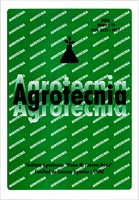View Item
- xmlui.general.dspace_homeCentros Regionales y EEAsCentro Regional Chaco - FormosaEEA Colonia BenítezArtículos científicosxmlui.ArtifactBrowser.ItemViewer.trail
- DSpace Home
- Centros Regionales y EEAs
- Centro Regional Chaco - Formosa
- EEA Colonia Benítez
- Artículos científicos
- View Item
Efecto biostimulante de Trichoderma atroviride en zapallo anco (Cucurbita moschata Duch. ex Poir)
Abstract
Se evaluó el efecto bioestimulante de Trichoderma atroviride en el crecimiento de plantines y rendimiento comercial de zapallo (Cucurbita moschata). La etapa de plantin se evaluó en invernadero y los tratamientos fueron T0: control -sin inocular-; T1: 200 ml.m-2 y T2: 500 ml.m-2 de T. atroviride SC 108 conidios. A los 30 días se evaluó: número de plantas; longitud radical; altura del plantín; número de hojas; peso fresco y seco aéreo y radical e índice
[ver mas...]
Se evaluó el efecto bioestimulante de Trichoderma atroviride en el crecimiento de plantines y rendimiento comercial de zapallo (Cucurbita moschata). La etapa de plantin se evaluó en invernadero y los tratamientos fueron T0: control -sin inocular-; T1: 200 ml.m-2 y T2: 500 ml.m-2 de T. atroviride SC 108 conidios. A los 30 días se evaluó: número de plantas; longitud radical; altura del plantín; número de hojas; peso fresco y seco aéreo y radical e índice raíz/aéreo. Se halló diferencias significativas para altura de plantín en T1 respecto de T0 y T2. La media del peso fresco aéreo fue significativamente superior en T1 respecto a T2. El peso fresco radical fue superior estadísticamente en T2 respecto al resto. Plantines tratados con dosis más alta de T. atroviride registraron aumento en masa radical, e índices raíz/aéreo próximos a 1. El resto de las variables no registraron diferencias estadísticas entre tratamientos y T0. A campo, los tratamientos fueron T0: sin inocular; T2 y T3 inoculados con 20 ml.m-2 y 50 ml.m-2 en etapa de plantin respectivamente, y adición de 3 l.ha-1 de T. atroviride SC 108 conidios al trasplante. Se cosechó 100, 108 y 115 días posteriores al trasplante (DPT). Se evaluó cantidad de plantas que prosperaron a cosecha, número y peso de frutos por planta. El T2 se diferenció significativamente superando a T0 y T1 en número de plantas a cosecha. El número de frutos no mostró diferencias significativas en las diferentes cosechas. No obstante, T2 evidenció mayor peso de frutos comerciales cosechados a los 108 DPT, dando una mayor precocidad.
[Cerrar]
The biostimulant effect of Trichoderma atroviride on seedling growth and commercial yield of pumpkin (Cucurbita moschata) has been assessed. The seedling stage was evaluated in a greenhouse and the treatments were T0: control -without inoculation-; T1: 200 ml.m-2 and T2: 500 ml.m-2 of T. atroviri-de SC 108 conidia. After 30 days, number of plants; root length; seedling height; number of sheets; aerial and root fresh and dry weight and root/aerial index
[ver mas...]
The biostimulant effect of Trichoderma atroviride on seedling growth and commercial yield of pumpkin (Cucurbita moschata) has been assessed. The seedling stage was evaluated in a greenhouse and the treatments were T0: control -without inoculation-; T1: 200 ml.m-2 and T2: 500 ml.m-2 of T. atroviri-de SC 108 conidia. After 30 days, number of plants; root length; seedling height; number of sheets; aerial and root fresh and dry weight and root/aerial index were evaluated. Significant differences were found for seedling height in T1 compared to T0 and T2. The average air fresh weight was significantly higher in T1 compared to T2. The root fresh weight was statistically higher in T2 compared to the rest. Seedlings treated with higher doses of T. atroviride registered an increase in root mass, and below ground biomass indexes were closer to 1. The other variables did not register any statistical difference between treatments and T0. In the field, the treatments were as follows: T0: without inoculation; T2 and T3 inoculated with 20 ml.m-2 and 50 ml.m-2 in seedling stage respectively, and addition of 3 l.ha-1 of T. atroviride SC 108 conidia to the transplant. At 100, 108 and 115 days after the transplant (DPT), it was harvested. The number of plants that remained until the harvest and the fruits’ ammount and weight per plant were considered. T2 differed significantly, surpassing T0 and T1 in number of plants at harvest time. The amount of fruits did not show significant differences along the harvests. However, T2 showed greater weight of commercial fruits harvested at 108 DPT, providing greater precocity.
[Cerrar]

Fuente
Agrotecnia / Universidad Nacional del Nordeste 32 : 14-21. (2022)
Date
2022-12
Editorial
Instituto Agrotécnico, Universidad Nacional del Nordeste
ISSN
0328-4077
2545-8906
2545-8906
Formato
pdf
Tipo de documento
artículo
Palabras Claves
Derechos de acceso
Abierto
 Excepto donde se diga explicitamente, este item se publica bajo la siguiente descripción: Creative Commons Attribution-NonCommercial-ShareAlike 2.5 Unported (CC BY-NC-SA 2.5)
Excepto donde se diga explicitamente, este item se publica bajo la siguiente descripción: Creative Commons Attribution-NonCommercial-ShareAlike 2.5 Unported (CC BY-NC-SA 2.5)


